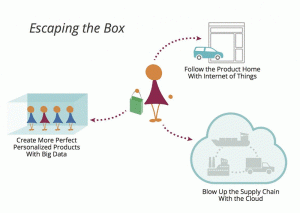It seems that every tool and platform is adding artificial intelligence. Here’s a guide for marketers who want to kick the tires.

Artificial intelligence (AI) is everywhere these days. Platforms of all sizes are claiming some kind of AI, making it hard for the rest of us to gauge their claims.
Here’s an analogy: Let’s say you go to buy a car.
The salesman at the dealership tells you that the car in question has four sturdy tires, windshield wipers, automatic detection of cars in the next lane when you have the turn signal on — and it flies over rivers.
Chances are, you would sort these features into three buckets: tires and wipers are standard, detection in the next lane is new but increasingly popular, and you never heard of a car that flies over rivers.
Shopping for martech is kinda like that right now. Now, let’s say you, a marketer, are considering a tool or platform that has AI-based claims. You’ll probably want to put those claims into similar buckets.
But in the world of martech and AI, what are the buckets — or the rules of thumb — you can use for assessing what’s real, what’s useful and what’s risky? Here’s our guide.
Self-teaching tech
First of all, what’s the handiest way of thinking about AI?
For industry analyst David Raab, AI is self-teaching technology that learns through pattern recognition.
That, he points out, is the basis for its ability to handle those things which commonly fall under its heading: predictive analytics, conversational logic, machine vision, anomaly detection, classification, natural language processing, speech recognition and sentiment analysis, to name several commonly-cited functions.
Plus, self-teaching underlies some of the more cutting-edge capabilities, like conceptual understanding, creating content or making aesthetic judgments. “Jeopardy”-winning Watson exhibits conceptual understanding, and New York City-based Persado is an example of content creation.
In the latter category of aesthetic judgments, Raab gives the example of a new app called ScopeStyle, where you upload a photo of clothes you like. The app will find similar product styles online and help you put together an outfit.
Salesforce VP of Product Leslie Fine generally agrees with Raab’s thumbnail definition of AI’s defining characteristic: discovering patterns and getting better over time. To which she adds that there are four main buckets for AI functionality:
- Discovery from volumes of data, which includes classification, anomaly detection, machine vision, natural language detection, sentiment analysis and the first step of insights.
- Prediction, which projects those patterns into the future and determines what is likely to happen next.
- Recommendations, in which AI uses those predictions to suggest an action.
- And intelligent Automation, where AI takes the recommendation and implements them.
Fine noted that conversational logic or content creation, as an example, falls into all four categories. As a rule of thumb, the more categories the AI functions cover, the more of a reach it might be.
Questions to ask
Pegasystems CTO Don Schuerman agrees that “everyone’s sticking AI on their brand,” but he recommends a few practical questions a marketer can ask to kick the tires:
- Can it be governed and controlled by business users? This determines, of course, whether you need a team of data scientists to do anything.
- Is that capability regularly being used by other organizations? Machine learning — which drives predictive analytics, as well as most of AI’s other functions — has algorithms that are decades old, Schuerman pointed out. What’s different: the scale at which machine learning can be applied nowadays. Similarly, he said, “next best actions,” recommendations and risk analysis are proven capabilities.
- Is it real-time? In this age when customer experience is paramount, the marketer needs to know if the capability can be used with customers in the moment.
- Will it operate across all channels, and across the customer’s journey? Including, increasingly, the offline experience in physical stores.
- Is the decision-making process transparent? This is a problem with cutting-edge deep learning technologies, he noted. They can’t tell you why they make decisions. Schuerman said it’s fine to have decision-making inside a black box for, say, vision recognition, but not fine for determining if you want to approve a mortgage for someone.
In the former, you can readily tell if the machine correctly determined the photo shows a cat. In the latter, you need to know why it said this person is a good credit risk.
Be wary and be testing
Sometimes, the “insights” that many AI-infused tools tout are transparent about their reasons, while at other times they result from black box processes. The marketer needs to know which kind is being offered, and if the level of risk from untraceable insights is worthwhile.
“I’m not suggesting that opaque AI is bad,” Schuerman said. “But it has a different level of risk.”
Ultimately, Salesforce’s Fine cautioned, be wary of AI-labeled products that help you do what you’ve always done, without much improvement. Obvious advice, but it’s good to look past the flash to determine if this capability really adds anything.
And, in the same Department of Obvious Advice, Raab noted that “it’s useful to know what AI is likely to be good at — but always test, test, test.”
Marketing Land – Internet Marketing News, Strategies & Tips
(72)
Report Post







